Listen:
Check out all episodes on the My Favorite Mistake main page.
My guest for Episode #307 of the My Favorite Mistake podcast is Terry Whalin, an accomplished editor and author of more than 60 books, several of which have sold over 100,000 copies. Terry is the owner of Whalin and Associates, a communications firm, and he serves as an acquisitions editor for Morgan James Publishing. Drawing from decades of experience in both writing and publishing, Terry shares a favorite mistake that changed the course of his career—offering valuable insights for first-time authors and seasoned professionals alike.
His most recent book is 10 Publishing Myths: Insights Every Author Needs to Succeed.
Terry’s favorite mistake took place in 2007, when a high-profile publishing event jolted him into realizing just how little he was doing to promote his own books. Despite having secured multiple six-figure advances and a long list of published titles, Terry was receiving negative royalty statements—his books weren’t earning out. That wake-up call led him to take what he calls 100% responsibility for his own success, adopting a daily commitment to book promotion, content creation, and building an online presence. From that turning point, he launched a blog (now with over 1,700 posts), grew a substantial social media following, and became a consistent voice in the author education space.
In the conversation, Terry and Mark explore the myths and realities of book publishing—especially the misconception that a publisher will handle marketing. Terry outlines how today’s authors must become active promoters, the importance of building an email list you control, and why giving away ebooks can actually drive print book sales. He also shares hard-earned lessons about evaluating publishers, avoiding scams, and understanding how traditional and independent publishing models differ. Whether you’re writing your first book or navigating your next launch, Terry’s insights are a masterclass in professional ownership and long-term thinking.
Questions and Topics:
- What’s your favorite mistake?
- Was it just a bad assumption to think publishers would promote your book, or do they sometimes mislead authors?
- Is the idea that a publisher will handle marketing one of the common myths in publishing?
- What specific actions did you start taking after realizing you needed to take full responsibility for your book’s success?
- Are you actively guesting on podcasts and using social media today to promote your work?
- Do social media efforts actually help sell books—or is it more about visibility and exposure?
- What’s your take on claims like “#1 Amazon bestseller”—do those really help authors sell books?
- Can you explain how the Morgan James model differs from traditional publishing?
- Why do you ask authors to commit to buying 2,000 copies of their own book?
- What role does giving away ebooks play in driving print sales?
- What should authors consider when deciding between traditional, hybrid, or independent publishing?
- How can aspiring authors avoid getting scammed by predatory publishing companies?
- What’s the role of an acquisitions editor, and how do you evaluate submissions?
- Do pre-orders really matter for bookstore placement?
- Why should authors consider writing for magazines or newspapers to build their platform?
- Do you think authors give up too early on marketing their books?
- Is building an email list still essential for authors, even in the age of social media?
- Should authors be cautious about relying too much on platforms like Facebook or LinkedIn?
Scroll down to find:
- Video version of the episode
- How to subscribe
- Quotes
- Full transcript
Find Terry on social media:
Video of the Episode:
Quotes:
Click on an image for a larger view
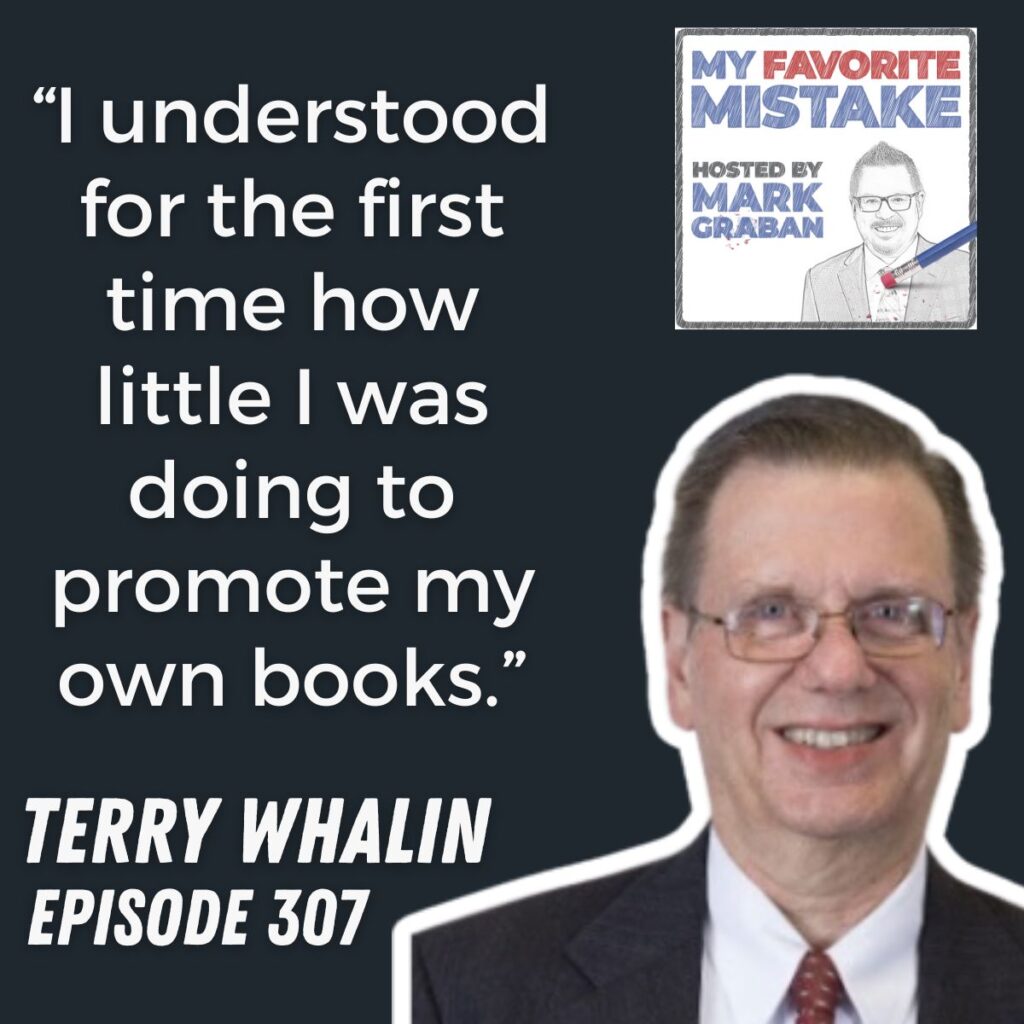
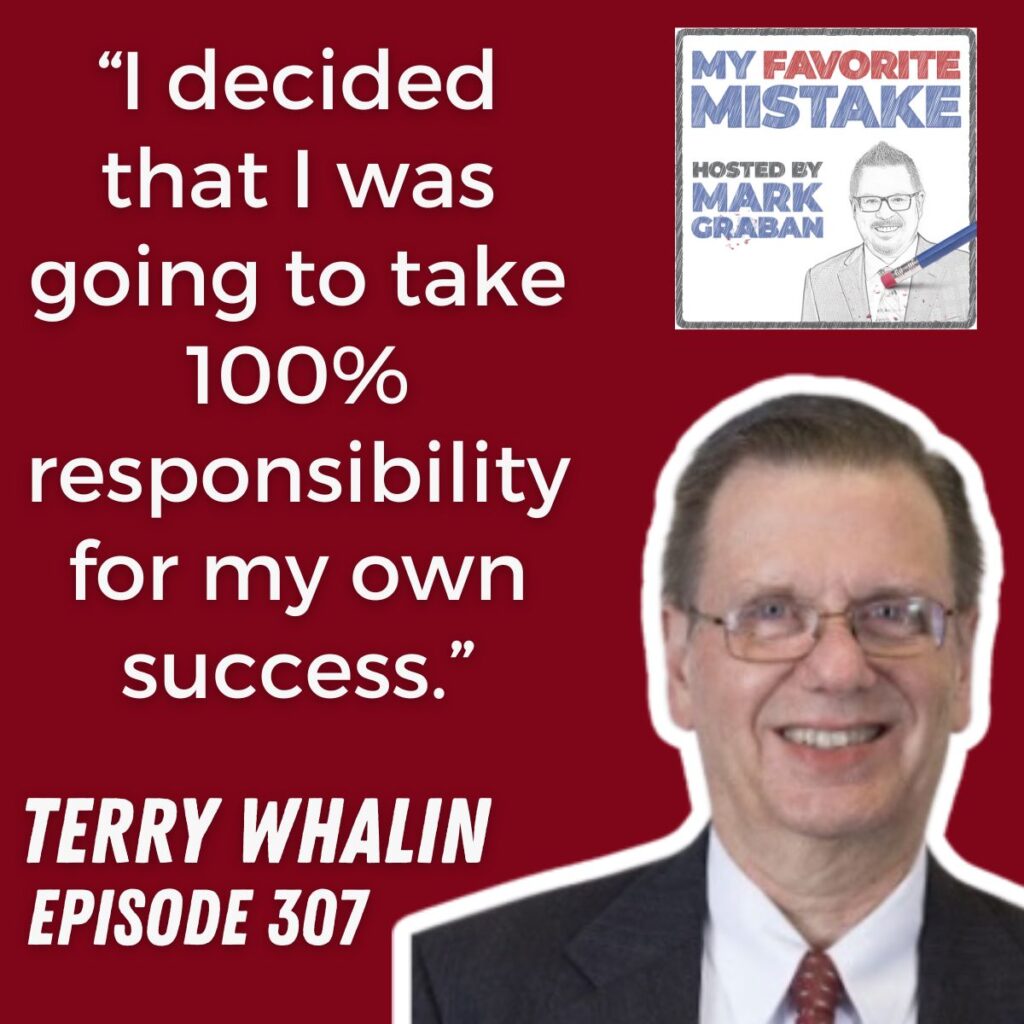
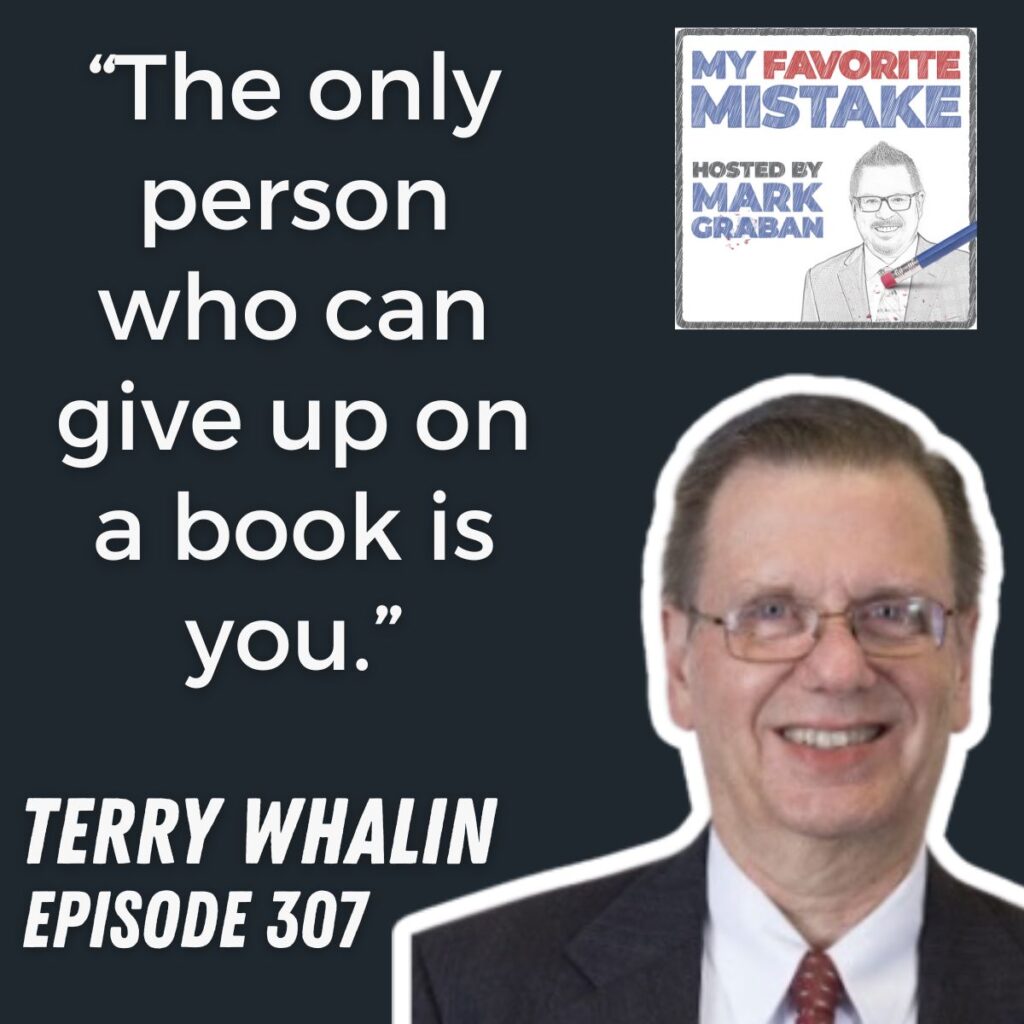
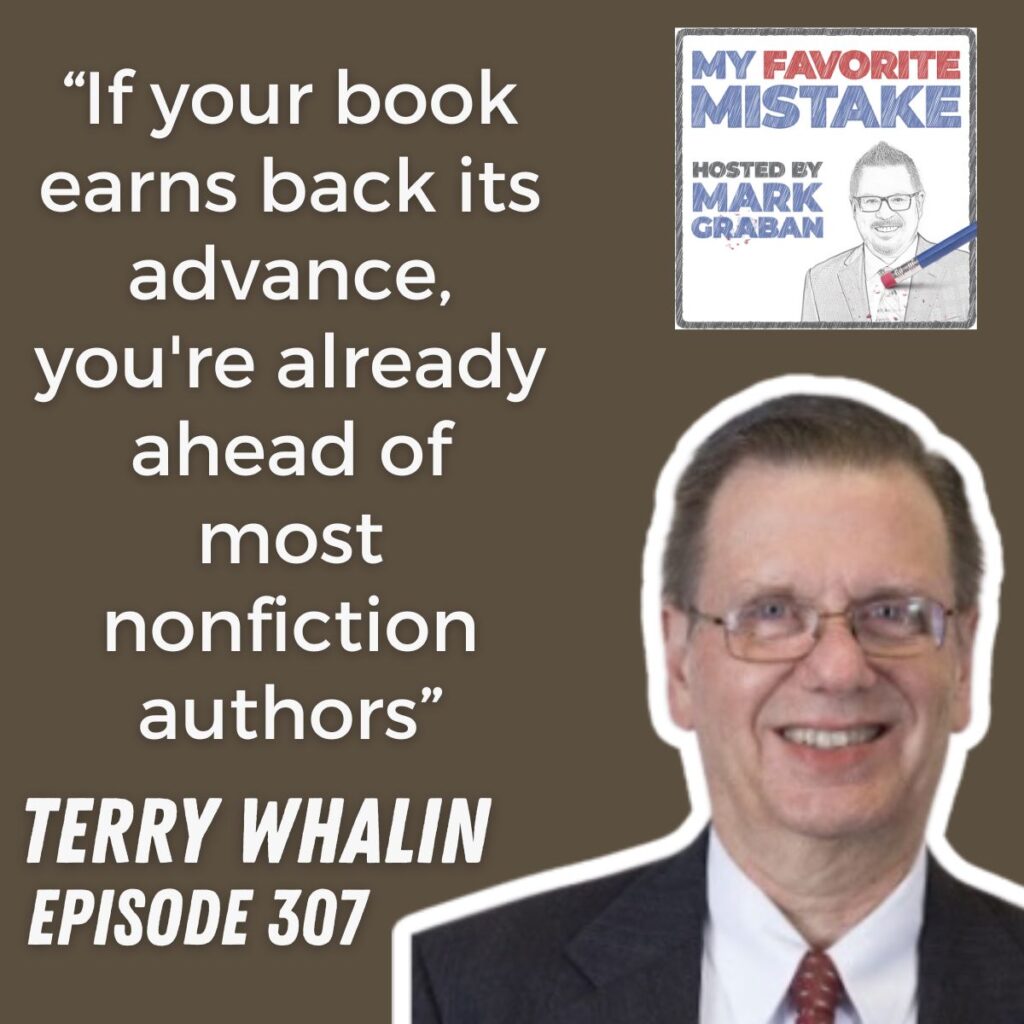
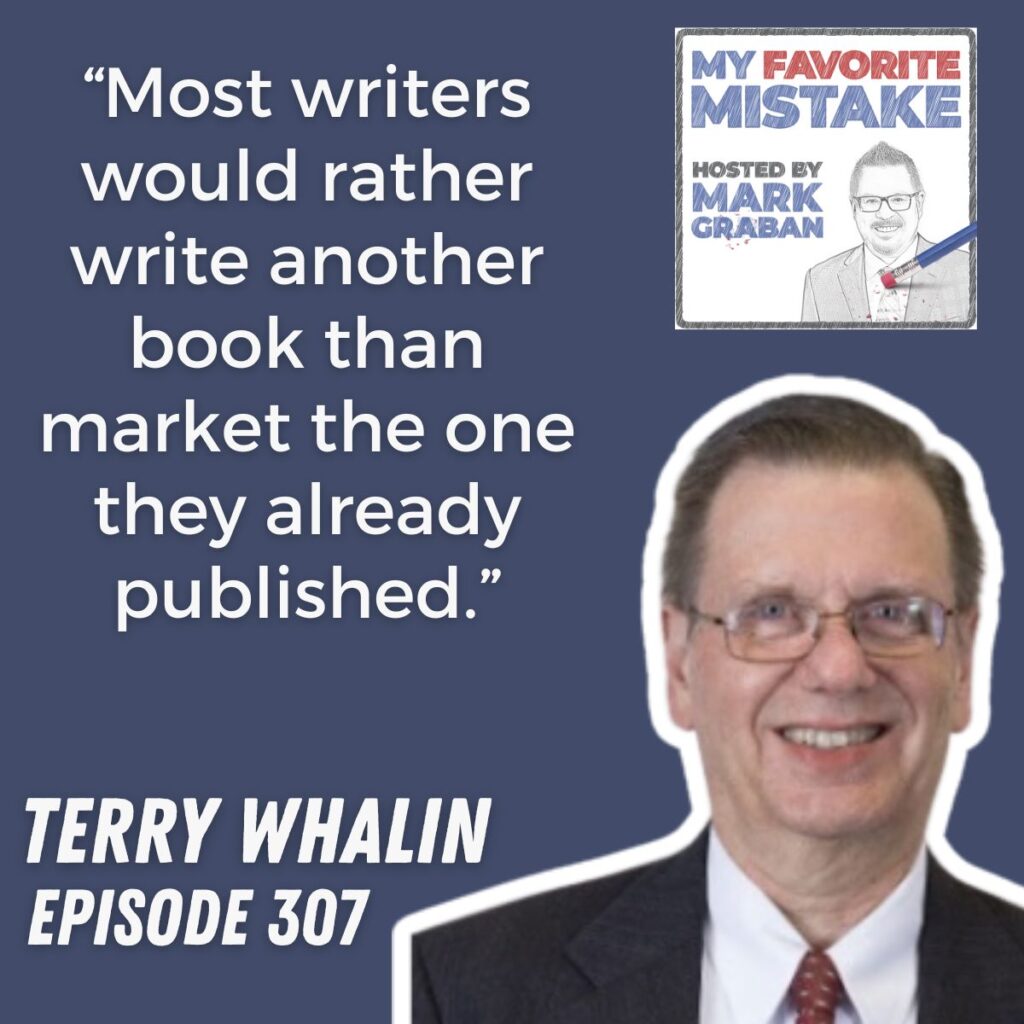
Subscribe, Follow, Support, Rate, and Review!
Please follow, rate, and review via Apple Podcasts, Podchaser, or your favorite app — that helps others find this content, and you'll be sure to get future episodes as they are released weekly. You can also financially support the show through Spotify.
You can now sign up to get new episodes via email, to make sure you don't miss an episode.
This podcast is part of the Lean Communicators network.

Other Ways to Subscribe or Follow — Apps & Email
Automated Transcript (May Contain Mistakes)
Mark Graban:
Hi, welcome to My Favorite Mistake. I'm your host, Mark Graban. Our guest today is Terry Whalin. He's an editor and author of more than 60 books, and he's written for more than 50 magazines. Several of Terry's books have sold over 100,000 copies.
His latest book—I’ve got a copy of it here—is 10 Publishing Myths Every Author Needs to Succeed. Terry is owner of Whalin and Associates, a full-service editing, writing, and communications firm. He is also an acquisitions editor for Morgan James Publishing. Joining us from Southern California—welcome, Terry. How are you?
Terry Whalin:
Mark, wonderful to be here with you. Thank you so much.
Mark Graban:
I'm jealous of your Southern California weather this time of year as we record in mid-December. I hope you're enjoying that.
Terry Whalin:
Yeah, it's pretty great. And people do envy us all over the country the way the weather is this time of year.
Mark Graban:
So, being in that weather—not a mistake—not what we're here to talk about. I have a lot of questions for you about writing and editing and publishing mistakes. We'll see if I've made any of them as you talk us through some of these. But first things first, looking at your career, Terry: what’s your favorite mistake?
Terry Whalin:
Well, Mark, my favorite mistake—or biggest one—is really something that happened in 2007. Mark Victor Hansen, the co-author of Chicken Soup for the Soul, invited me out to California. He was having the Mega Book Marketing University out there. I was a literary agent back then and living in the Phoenix area, so it was inexpensive for him to fly me to Los Angeles.
I got out there and took pictures of people during the conference, but I also sat with everybody else and listened to the speakers. And one of the things that happened during that event—it was almost like I woke up from being asleep as an author. At that point in my life, I had published about 50 books. Twice, I had received six-figure advances from big publishers. I was getting advances.
But what publishers do is send you a royalty statement once a year or quarterly, showing how your books are doing. I was getting mine—and they were all in the minus category because my books weren’t selling and earning.
Mark Graban:
They weren’t getting past what the advance was.
Terry Whalin:
Exactly. They weren’t earning past the advance. So I was receiving negative royalty statements. And while I was there, it hit me: I understood for the first time how little I was doing as an author to promote my own books. I had a TerryWhalin.com website, but I was doing nothing else.
Publishers were making pretty books, getting them into bookstores. But I was doing nothing to encourage people to go into those stores and buy the books and actually move them off the shelves. One of the speakers at that event was Jack Canfield, the other co-author of Chicken Soup for the Soul. Jack wrote a book called The Success Principles. And the very first principle says: “I will take 100% responsibility for my own success.”
Now, none of us want to do that. We want somebody else—our agent, our publisher, our assistant—to do it. But during that event, I made a decision. I made a change in my life from that mistake. I decided that I was going to take 100% responsibility for my own success.
And so, back then, I started blogging every week. My blog now has over 1,700 entries. About a year ago, I found an article that said I was one of the top 27 content producers among 600 million blogs. That’s because I decided to take 100% responsibility and do something proactive every day—or at least several times a week—to promote my book.
Mark Graban:
Yeah, I mean, that’s a lesson I’ve learned along the way. I know it’s one of the myths in 10 Publishing Myths, as I was going through it. Thank you again for sending me the book. Myth #2: “My publisher will sell and promote my book.”
My first couple of books were through a trade publisher—not one of the big ones—and my books weren’t really in physical bookstores. It was all Amazon or the publisher’s website or other online sources. So that really resonates with me—this idea that even if you have a publisher, a lot of the marketing falls on you as the author.
Terry Whalin:
Yeah, publishers care. They want to sell books—don’t get me wrong. But at the end of the day, their interests are divided, depending on how many books they’re publishing. They have other things to promote and focus on besides you. Your focus and your passion are really on your book—and that’s what you need to tap into and use.
Mark Graban:
That mistake you were making—not promoting your own books—is a very common situation. Enough for you and others to write books and do things to try to wake people up. Is that just a bad assumption authors make? Do publishers sometimes portray that they’re going to do more than they actually can?
Terry Whalin:
Yeah, there are misstatements from publishers. I’ve had publishers promise me the moon in terms of what they were going to do. Then, after I signed, a lot of those promises disappeared. I think in general, most writers are introverts. I’d rather sit in the corner and read a book than stand up and talk in front of people.
And so, that alone—our natural tendency—is to write another book instead of doing the marketing and promotion that’s necessary. But at that event, I got the message: I had to be doing something, and something significant.
Canfield and Hansen—when Chicken Soup came out—they practiced what they called the “Rule of Five.” They did five things every day to promote their book. They were rejected over 140 times. But when they finally found a publisher, they said they’d sell a million books in the first year. The publisher laughed—they’d never sold a million of anything. But it took them a year and a half. And now that series is one of the best-selling in the English language—millions and millions of copies.
Mark Graban:
Yeah, it’s like the old McDonald’s sign: “billions served.” With that series, it’s definitely in that territory. So now, with your current book, how are you approaching things? Are you guesting on a lot of podcasts? Doing more with social media?
Terry Whalin:
Yes, absolutely. Back in 2007, there was hardly any social media. Now, I’ve got 175,000 followers on X (Twitter), and over 19,500 connections on LinkedIn. I ignored LinkedIn for a while, but now I focus on just a few platforms and use them consistently. I post 12 to 15 times a day on those platforms.
That effort pays off in the long run. One thing we’ve learned in the book business is that someone usually needs to hear or see your book seven, eight, even twelve times before they actually pull out their wallet and buy it. Social media gives you that exposure. We don’t necessarily sell books through social, but publishers still care a lot about your numbers because of that ongoing visibility.
Mark Graban:
It’s easy to count—it’s quantifiable. Whether it directly translates to sales, that’s harder to know. But I had a publicity person once who told me, “TV might be good for your ego, but radio—and I think by extension, podcasts—are what actually sell books.”
Terry Whalin:
I think that’s true. One of the hardest parts of publishing is that there’s no single, firm path to success. If there were, every book would be a bestseller. But that’s not the case. Over 11,000 new books come out every day—including self-published titles. That’s a lot of competition.
Mark Graban:
Yeah, it’s not just about selling books—it’s a battle for time and attention. You also see a lot of authors claiming to be “bestselling authors.” That phrase doesn’t have a real, defined legal meaning.
Let me ask your take: does it really help to claim “#1 Amazon Bestseller,” even if the book has only two reviews and hasn’t charted in a meaningful way?
Terry Whalin:
That’s a great question. At Morgan James, we actually train our authors not to use the word “Amazon.” Amazon is a big customer for us, but it’s only 24% of our business. Some publishers claim it’s 60%.
Regardless, bookstore owners believe Amazon has destroyed their business. They hate the word. They don’t want to hear about your Amazon reviews. If you have 50 reviews, that’s interesting—but don’t lead with “50 Amazon reviews.”
Mark Graban:
That’s a good point. I think there’s a difference between legitimately selling a large volume of books nationwide versus hitting #1 in some obscure Amazon category for a day and a half. All bestsellers are not created equal.
Terry Whalin:
No, that’s exactly right. There are different ways to define that word “bestseller.” That’s why, in my introduction, I made a point of saying that several of my books have sold over 100,000 copies. That kind of quantifies the success—it’s not just a title, it’s actual sales.
Mark Graban:
Looking back at those earlier books, did you ever have a nagging feeling that they should have sold more copies? Was there one book in particular where you thought, “If I’d approached that differently, it could have reached more people”?
Terry Whalin:
Yeah, probably more than one. Early in my career, I did a lot of what we call “work-for-hire” books. The publisher hired me to write the book, and I signed over all rights to them. When you do that kind of work, you really have less incentive to promote and sell the book.
But even as a hired gun, I still tried to do my part to support the book. Still, it’s different than when you’re publishing under a royalty arrangement and the success of the book has a direct impact on your income.
Mark Graban:
Right. I’ve never been paid advance royalties, but I understand that when people get advances, it’s based on projected future royalties. If the book doesn’t earn out, do you have to pay that advance back?
Terry Whalin:
No, the publisher takes the loss. That’s a good question, and I’ve never had to repay an advance. I’ve been in situations where it looked close—like I might have to—but I never have. And the reality is, most nonfiction books never earn back their advance.
So if your book does earn out—even if the advance was modest, like $5,000—that puts you in a different category than most nonfiction authors.
Mark Graban:
And when authors are choosing between going with a traditional publisher or independently publishing, how do you advise them to think that through? I know I don’t like the phrase “self-publishing” because my company hires professionals the same way a publisher would. It’s not like I’m doing it all myself.
Terry Whalin:
Exactly. “Independent publishing” is a better term. The challenge is making sure you don’t get scammed in the process. There are a lot of very persuasive salespeople in the publishing world who can talk authors into spending thousands of dollars with little return.
Use your own tools—like Google. Type in the name of the publisher and add the word “complaints” or “scam” and see what comes up. Every publisher has someone who didn’t like them, sure. But if you see pages and pages of complaints, that’s a red flag.
I’ve met authors who spent $20,000 to self-publish a book—and they’re never going to earn that money back. They took every upsell these companies offered. It became a moneymaker for the publisher, not the author.
Mark Graban:
There’s a difference between being disappointed in a publisher’s performance versus getting trapped in an exploitative deal. I’ve heard from some authors who said their publisher forced a title on them that they hated—and they believe it hurt the book.
But there’s another tier, where you’re paying someone $20,000 upfront for services they may or may not deliver. That’s a different issue entirely.
Terry Whalin:
Exactly. You want a true partner in the publishing process. At Morgan James, our model is quite different. We’ve been named one of the top independent publishers nine times by Publishers Weekly. We’ve been around for over 20 years, with 6,000 titles and more than 25 million books sold.
We’ve had books on the New York Times list 29 times, and on the Wall Street Journal list hundreds of times. That kind of reach doesn’t happen without a strong presence in brick-and-mortar bookstores. We invite authors to talk to our other authors. Most publishers won’t let you do that. We welcome it.
Mark Graban:
That’s a good sign—when a publisher wants you to talk to their existing authors. If they’re hiding that, it’s probably a red flag.
How is the Morgan James model different, specifically?
Terry Whalin:
It’s different in a few key ways. First, we collaborate with the author on every step of the process: cover design, title, pricing, trim size, launch date—everything. We don’t just shove a finished product in front of them.
Second, we work faster than traditional houses. If you turn in an edited manuscript, we can have printed books in your hands in about three months. The book will be in stores in about nine months, compared to the 18–24 month timelines of traditional publishers.
Now, here’s what’s unusual: we ask authors to commit to buying 2,000 copies of their own book. They don’t need to buy them all at once—they have years to do it. But we ask for $3 over the printing cost per copy. So, $6,000 upfront. In exchange, they get books at a price they can sell or give away.
We invest $15,000 to $25,000 into every book we publish. And 80% of what happens after that—how the book sells—comes down to the author’s efforts.
Mark Graban:
That’s interesting. Compared to traditional publishers, where author copies might cost me $10–$15 each, being able to get books for $3 over print cost makes a huge difference, especially when you’re using books for speaking engagements or lead generation.
Terry Whalin:
Right. And we’re also doing something that’s very unusual—we help you grow your email list. A year and a half ago, we learned that when someone downloads an ebook and starts reading it, there’s a high chance they’ll go buy the print version.
So our marketing team creates a custom landing page with your book cover and a “Free Book” button. You can promote that on podcasts or social media. If 1,000 people download your free ebook, we give you those 1,000 email addresses—and we count that toward your 2,000-book commitment. That’s something no other publisher I know is doing.
Mark Graban:
Yeah, that's brilliant. And I’ve worked with publishers who charged me 40% off the list price for author copies. That’s not a real discount—especially when you consider that retailers are buying books at 55% off. So in the past, it felt expensive to give books away. That’s what ultimately pushed me toward independent publishing.
Terry Whalin:
That’s very typical—40% to 50% off the retail price for author copies. And yeah, bookstores usually get better pricing than that. So when you’re paying that much, it’s hard to justify giving books away or using them as a tool in your business model.
Mark Graban:
Right. So the difference between paying $12 or more versus $4 per copy—especially for bulk orders—that really changes the game, particularly for business authors. If you're using the book to generate leads, close deals, or support speaking engagements, that flexibility is huge.
Terry Whalin:
Exactly. And you know, everyone thought ebooks were going to overtake print books. But that didn’t happen. I was on a webinar with Markus Dohle, then-CEO of Penguin Random House, and he said their global numbers were 80% print and 20% ebook.
So, despite all the predictions, print is still dominant. Ebook sales help, but they never replaced print the way some people expected.
Mark Graban:
Yeah, I see similar numbers with my books—usually around 70% to 80% print, with the rest being ebook. One thing I clashed with a previous publisher on was ebook pricing. They were happy for me to give away a short sample, but they stubbornly priced the full ebook almost the same as the print edition. That felt like a mistake—it was as if they didn’t want to sell ebooks.
Terry Whalin:
That’s right. Ebooks should be discounted. Giving them away, or offering them for 99 cents occasionally, is a smart move. They drive exposure and—ironically—more print sales. Not everyone reads electronically, of course. I don’t, even though I promote them heavily.
Mark Graban:
You’ve had so many experiences across writing, editing, and acquisitions. For people who are thinking about working with a publisher—whether Morgan James or anyone else—what’s the role of an acquisitions editor? A lot of people might not know what that involves.
Terry Whalin:
An acquisitions editor is a hunter and a gatherer. I’m often the first person to read the submissions that come in. I talk to the author, find out what connections they have to sell books, look at their social media presence and platform.
I ask why they wrote the book and whether it fits the kinds of books we publish. For example, at Morgan James, we don’t do high-end coffee table books or poetry. Those are outside our focus. We receive over 5,000 submissions a year and publish only 180 to 200. So, there’s definitely a filtering process.
Mark Graban:
That reminds me of angel investors who review pitches—deciding which ideas to bet on. There’s no perfect crystal ball, but you try to make informed decisions and hope some of them take off.
Terry Whalin:
That’s right. You do the best you can with the information you have. Even then, sometimes we sign authors who turn out to be difficult. I’ve had authors who were kind and respectful with me, but weren’t the same with our production team or copy editors.
And that matters. Publishing is a small world. If someone is hard to work with, that reputation spreads quickly—even if the interactions are remote. I've been at conferences where someone I met as a junior publicist one year came back the next year as VP of publicity. So treat everyone with respect. It makes a big difference.
Mark Graban:
That’s great advice—how you treat people always matters. Speaking of the broader publishing process: what’s your view on pre-orders? Are they still important in today’s landscape?
Terry Whalin:
Yes, pre-orders are very important. We encourage our authors to push not just Amazon, but Barnes & Noble, Books-A-Million, Chapters Indigo (in Canada), and others.
Our national Barnes & Noble rep told us if we can get 300 pre-orders through their website, that can tip the scale for national in-store placement. It’s a big deal. That can get your book stocked in stores across the country.
But even then, it’s the author who moves the book—who drives people to go in and buy it. Most people don’t know that bookstores operate on consignment. If a book doesn’t sell, it can be returned to the publisher for a full refund. That’s why you see so many hardcovers marked down in the bargain section—they’re on their way out.
Mark Graban:
That’s helpful context. And in your book, 10 Publishing Myths, each chapter ends with specific actions for the reader, not just things to avoid. Even as an experienced author, I found new value there—like your section on writing magazine articles.
Terry Whalin:
Yes, the magazine world is often overlooked. If your book sells 5,000 copies over its lifetime, that’s considered good. But a single magazine article can reach 100,000, 200,000, or even 500,000 people. At the bottom of that article, you can include your name and website—and drive traffic and awareness that way.
In publishing, we want to publish people who’ve already been published. It’s like the catch-22 of job hunting: you need experience to get the job, but you need the job to get experience. Writing for magazines—even small ones—proves that you understand the craft, audience, structure, and storytelling. It’s excellent practice.
Mark Graban:
Would you say the same about op-eds in newspapers?
Terry Whalin:
Yes—op-eds, articles, guest columns… all great options. There are tons of outlets out there. The key is finding the right fit for your topic and submitting to the right person. Get the latest market guide at your library, and do your research before submitting.
Mark Graban:
There are so many strategies out there—writing, social media, podcasts, video. I’ve tried to push myself toward more video content, even though it doesn’t come naturally. I’ve resisted TikTok. Maybe I’m making a mistake there?
Terry Whalin:
There are lots of different ways to market. I’m not on TikTok myself, but some people start YouTube channels, some do reels, some blog. The key is to pick something you can control.
I talk to authors who say, “I built my whole list on Facebook or LinkedIn.” But you don’t own those platforms. You can get kicked off or lose access. That’s why I tell authors: build on something you own. Start your email list. Use it consistently.
Mark Graban:
A previous guest once said, “Don’t build your castle on someone else’s land.” She learned that the hard way after losing access to her platform. Building your own email list is slow, but it’s yours.
Terry Whalin:
Exactly. The email list is key. If you don’t have one, start one. And don’t just let it sit there—use it. Communicate. Engage. That’s how you build long-term success.
Mark Graban:
Well, Terry, thank you so much for being here. 10 Publishing Myths really is a great, quick read. It even says on the back—something I’ve never seen before—“Read time: 108 minutes.”
Terry Whalin:
Yes, that’s something Morgan James is doing now, and I think it’s helpful. I also have a special offer for your listeners. They can go to publishingoffer.com and get the book for around $10 including shipping, plus over $200 in bonuses.
Also—I have an “11th myth” that didn’t make it into the book. Alice Kreider, an acquisitions editor, told me: “Terry, you’re missing a big one. Authors think, ‘If I send my book to Oprah, she’ll put me on her show.’” So I wrote that chapter, and people can get it free at terrylinks.com/11thmyth.
Mark Graban:
Great URLs—easy to say out loud on a podcast. You’ve clearly thought that through. Thanks again for being a great example and for generously sharing your lessons and your favorite mistake.
Terry Whalin:
Thank you, Mark. I really appreciate the opportunity. And one final encouragement: I’ve been in top literary agencies and publisher offices in New York City. Even when they reject your work, they’re still actively looking. They want the next big thing. They ask me all the time: “Where’s the next Joel Osteen? Where’s the next bestseller?”
So no matter what rejection letters say—just know they are reading. They are looking. You just have to keep pitching and get yourself in the right place at the right time.
Mark Graban:
That’s a great note to end on. Thanks again, Terry.

